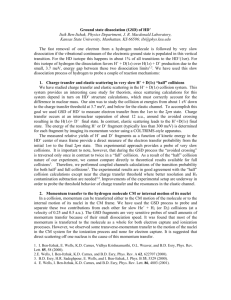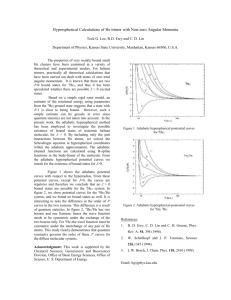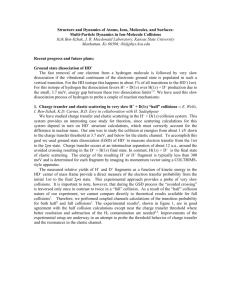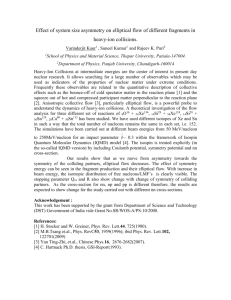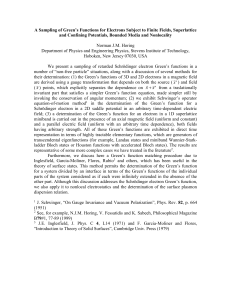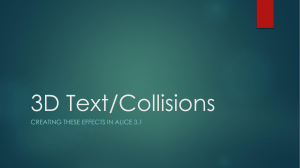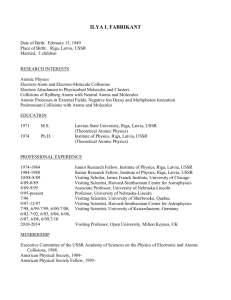THEORETICAL STUDIES OF INTERACTIONS OF ATOMS
advertisement
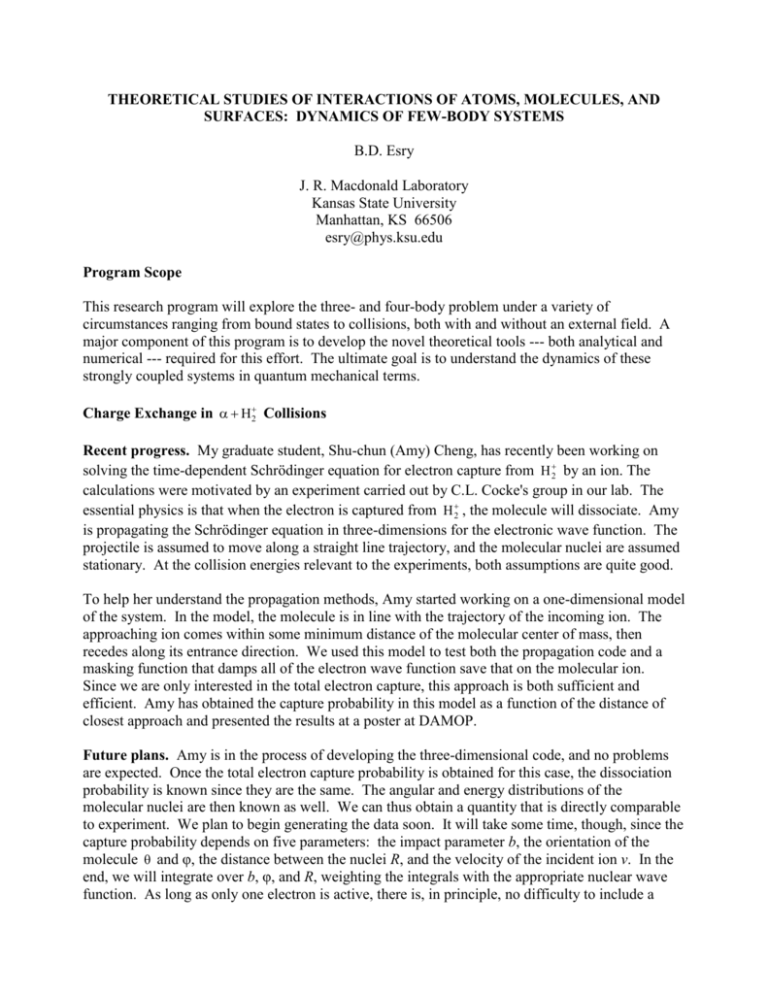
THEORETICAL STUDIES OF INTERACTIONS OF ATOMS, MOLECULES, AND
SURFACES: DYNAMICS OF FEW-BODY SYSTEMS
B.D. Esry
J. R. Macdonald Laboratory
Kansas State University
Manhattan, KS 66506
esry@phys.ksu.edu
Program Scope
This research program will explore the three- and four-body problem under a variety of
circumstances ranging from bound states to collisions, both with and without an external field. A
major component of this program is to develop the novel theoretical tools --- both analytical and
numerical --- required for this effort. The ultimate goal is to understand the dynamics of these
strongly coupled systems in quantum mechanical terms.
Charge Exchange in H2 Collisions
Recent progress. My graduate student, Shu-chun (Amy) Cheng, has recently been working on
solving the time-dependent Schrödinger equation for electron capture from H 2 by an ion. The
calculations were motivated by an experiment carried out by C.L. Cocke's group in our lab. The
essential physics is that when the electron is captured from H 2 , the molecule will dissociate. Amy
is propagating the Schrödinger equation in three-dimensions for the electronic wave function. The
projectile is assumed to move along a straight line trajectory, and the molecular nuclei are assumed
stationary. At the collision energies relevant to the experiments, both assumptions are quite good.
To help her understand the propagation methods, Amy started working on a one-dimensional model
of the system. In the model, the molecule is in line with the trajectory of the incoming ion. The
approaching ion comes within some minimum distance of the molecular center of mass, then
recedes along its entrance direction. We used this model to test both the propagation code and a
masking function that damps all of the electron wave function save that on the molecular ion.
Since we are only interested in the total electron capture, this approach is both sufficient and
efficient. Amy has obtained the capture probability in this model as a function of the distance of
closest approach and presented the results at a poster at DAMOP.
Future plans. Amy is in the process of developing the three-dimensional code, and no problems
are expected. Once the total electron capture probability is obtained for this case, the dissociation
probability is known since they are the same. The angular and energy distributions of the
molecular nuclei are then known as well. We can thus obtain a quantity that is directly comparable
to experiment. We plan to begin generating the data soon. It will take some time, though, since the
capture probability depends on five parameters: the impact parameter b, the orientation of the
molecule and φ, the distance between the nuclei R, and the velocity of the incident ion v. In the
end, we will integrate over b, φ, and R, weighting the integrals with the appropriate nuclear wave
function. As long as only one electron is active, there is, in principle, no difficulty to include a
polyatomic target, or even a molecular projectile. These cases will, of course, require careful
modelling to reduce them to one active electron, but they could be quite interesting to study.
Ionization in Ion-Atom Collisions
Recent progress. We have worked on applying the scaled coordinate method to the timedependent Schrödinger equation for ionization in ion-atom collisions. The advantage of the scaling
method is that it analytically removes much of the known behavior of the ionized wave function,
leaving only a smooth, stationary envelope to propagate. In particular, it alleviates the need for the
absorbing boundaries normally used in such calculations.
The primary effort on this project came from my postdoc, Wei Guo. He arrived in August 2001
and worked to apply the scaling method to a one-dimensional model of the collision. Using this
model gave us the opportunity to explore the scaling method for ion-atom collisions in an efficient
manner since the one-dimensional model already contains all of the elements peculiar to the scaling
method. Wei eventually got the code working and began to generate data for the one-dimensional
problem. It had become clear by this point, however, that Wei would not be able to take the project
further and was not really interested in working in atomic physics. Wei left my group at the end of
May, 2002. A replacement, Vladimir Roudnev, has been hired and should arrive around October
2002, at which time the subject of his project will be determined.
Future plans. While the numerical aspects of this method require care, there appear to be no
fundamental difficulties in extending the scaling to the three-dimensional ion-atom collision
problem. My plans for the near future, however, do not include this project since other efforts
appear more timely.
Protonium Formation in p H(1s) Collisions
Recent progress. The low-energy, less than roughly 10 eV, collision of p with hydrogen is one of
the most asymmetric systems one can consider. The difficulty lies in the fact that p and p can
form bound states with a ground state energy of approximately – 459 a.u. By comparison, the
energy in the incident channel is -0.5 a.u. The formation of protonium, Pn or pp , occurs when the
proton is captured by the antiproton, ionizing the electron in the process. Based on simple energy
arguments, the most likely Pn states produced are in the n=30 manifold. The extreme change in
length and energy scales --- going from truly quantum mechanical in the initial state to nearly
classical in the final state --- makes the problem extremely difficult to treat theoretically. Not
surprisingly, the experiment is also difficult to do. Nevertheless, the ASACUSA collaboration at
CERN predicts that they will make preliminary measurements of Pn formation within the next year.
Unfortunately for us, the target will likely be hydrogen molecules rather than atoms since the Pn
formation cross section is predicted to be larger from classical calculations.
It is tempting to apply the Born-Oppenheimer approximation to this problem, and many people
have. The Born-Oppenheimer curves, however, do not allow for the formation of Pn; the united
atom limit is a free electron. In collaboration with Hossein Sadeghpour at ITAMP, I have instead
used the adiabatic hyperspherical approach to generate potentials that do indeed correlate to the
p H(1s) limit as well as all of the Pn(n )+e- channels. Unfortunately, about 450 potential curves
are required to cover the energy range of interest. This multitude of channels and the strong
coupling between them is at the heart of the problems with asymmetric systems. To gain some
insight into the physics, we have artificially reduced the masses of p and p and carried out the
scattering calculations with these simpler systems. By examining several values of the mass, we
could identify the important channels. This work has been submitted for publication and has so far
resulted in two invited talks: one at an ITAMP workshop and the other at an ECT* workshop in
Trento, Italy.
Future plans. I want to combine the physical insight gained in our scaled-mass calculations with a
diabatic representation in order to reduce the number of channels in the full-mass problem. While
we have recently completed the manuscript describing our split diabatic approach, another diabatic
approach will likely be needed. The split diabatic representation requires one to identify all of the
curve crossings by hand --- an unreasonable task with 450 channels. We will thus seek alternative
diabatization schemes that can be applied more automatically. I anticipate that any method
successful for this system can be profitably applied to other collision systems, allowing quantum
mechanical calculations where none are now possible.
Low-Energy Ps+Ps Collisions
Recent progress. Roman Krems, a very capable Predoctoral Fellow at ITAMP who is soon to be a
postdoc there, recently spent two weeks at Kansas State to begin implementing my formulation of
an adiabatic hyperspherical approach for the low-energy collision of two Ps (e+e-) “atoms''. The
only four-body adiabatic hyperspherical treatments that have been done to date are for three
electron atoms (see C.D. Lin's report). With an infinitely heavy nucleus, this system has a natural
center about which to define approximately good angular momentum quantum numbers. In fact,
four electrons can been treated in the adiabatic hyperspherical approach for this same reason. The
equal mass problem that we are considering, however, does not have such a natural center, making
the necessary expansion over partial waves more slowly converging.
Because the adiabatic equation for the four-body problem in the center-of-mass (CM) frame
requires eight coordinates, we must expand the wave function using partial waves. There is one
spherical harmonic associated with each of the three relative position vectors in the CM frame,
accounting for six coordinates. The other two coordinates are our hyperangles. In principle, then,
coupled two-dimensional partial differential equations must be solved. This route very quickly
becomes too computationally demanding. Instead, we are diagonalizing the adiabatic equation for
a fixed set of { 1 , 2 , 3 ,}, then coupling these together to obtain the final result. Even though the
{0,0,0} curve by itself recovers more than 90% of the asymptotic Ps+Ps energy, we are finding that
the last few percent require many partial waves.
Future plans. The code seems to be nearly complete, but we are still struggling to achieve
convergence in the partial wave expansion. Roman will continue to work on this problem as a
postdoc, trying to determine whether our current difficulties are due to lingering bugs in the
program or to actual physics. Successful completion of this project will be an exciting
accomplishment since few other methods could similarly treat equal mass four-body systems for
both bound and collisional states.
Publications
1. “Boundary-free scaling calculation of the time-dependent Schrodinger equation for laser-atom
interactions,'' Z.X. Zhao, B.D. Esry and C.D. Lin, Phys. Rev. A 65, 042725 (2002).
2. “Charge transfer and elastic scattering in very slow H++D(1s) half collisions,'' E. Wells, K.D.
Carnes, B.D. Esry, and I. Ben-Itzhak, Phys. Rev. Lett. 86, 4803 (2001).
3. “Helium trimer has no bound rotational excited states,'' T.G. Lee, B.D. Esry, B.C. Gou, and C.
D. Lin, J. Phys. B 34, L203 (2001).
4. “Charge exchange in slow H++D(1s) collisions,'' B.D. Esry, H.R. Sadeghpour, E. Wells, and I.
Ben-Itzhak, J. Phys. B 33, 5329 (2000).
5. “Asymmetric branching ratio for the dissociation of HD+(1s ),'' E. Wells, B.D. Esry, K.D.
Carnes, and I. Ben-Itzhak, Phys. Rev. A 62, 062707 (2000).
5. “Boundary-free propagation with the time-dependent Schrödinger equation,'' E.Y. Sidky and
B.D. Esry, Phys. Rev. Lett. 85, 5086 (2000).
6. “Symmetry breakdown in ground state dissociation of HD+,'' I. Ben-Itzhak, E. Wells, V.
Krishnamurthi, K.D. Carnes, O.L. Weaver, and B.D. Esry, Phys. Rev. Lett. 85, 58 (2000).
